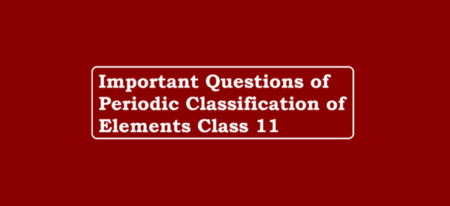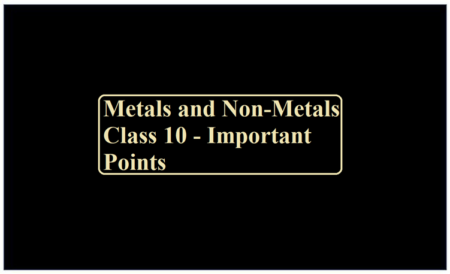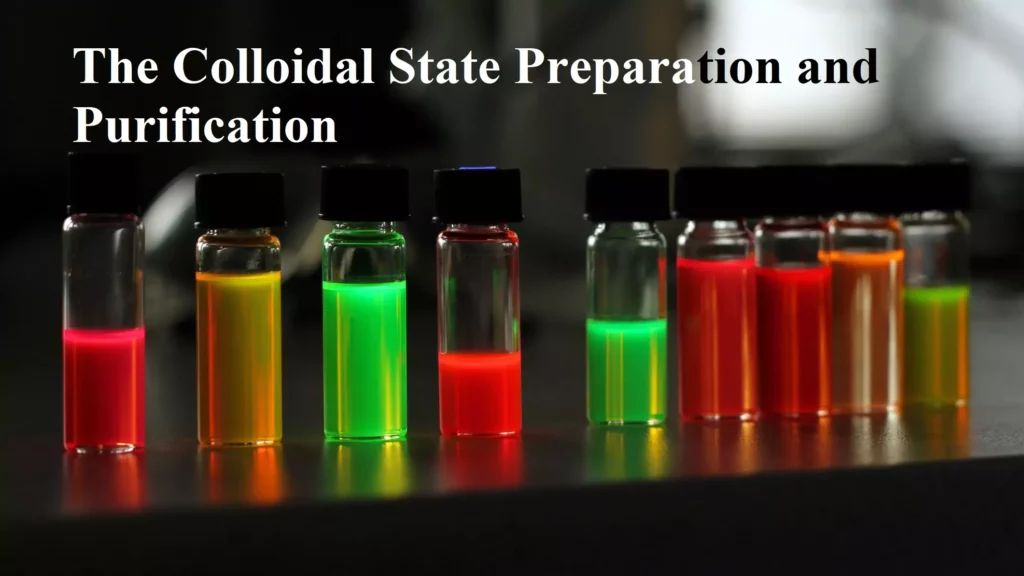Class 9 Science Chapter 2 Extra Questions and Answers
Que 1. How can you convert a saturated solution to an unsaturated solution without adding any solvent to it?
Ans 1. By heating a saturated solution, it becomes unsaturated.
Que 2. Salt can be recovered from its solution by evaporation. Suggest some other technique for the same?
Ans 2. The process of Crystallisation can be used to separate salt from its solution.
Crystallisation is a separation technique used to separate a solid in a solution. The solution is warmed in an open container, allowing the solvent to evaporate, leaving a saturated solution.
Que 3. How would you confirm that a colourless liquid given to you is pure water?
Ans 3. Under one atmospheric pressure, the boiling point of water is 100 0C and the freezing point is 0 0C. When we boil the given colourless liquid, if it boils then it is pure water. It does not boil at 100 0C temperature, then there must be impurities mixed with it, hence not pure water.
Que 4. Define solvent.
Ans 4. The component of the solution that dissolves the other component in it is called the solvent.
Que 5. Differentiate between true solution, colloidal solution and suspension.
Ans 5.

Que 6. What is meant by a substance?
Ans 6. A substance is a pure single form of matter. It consists of a single type of particle i.e. all the constituent particles in the substance are identical in their chemical nature. It cannot be separated into other kinds of matter by any physical process.
Que 7. Sucrose i.e sugar crystals obtained from sugarcane and beetroot are mixed together. Will it be a pure substance or a mixture? Give reasons for the same.
Ans 7. It is a pure substance because the chemical composition of sugar crystals is identical irrespective of its source.
Que 8. Seawater can be classified as a homogeneous and heterogeneous mixture. Comment.
Ans 8. The seawater contains a mixture of salt and some other bigger size impurities and a mixture of several gases. Due to different bigger sizes of contaminants, seawater is classified as a heterogeneous mixture. In contrast, it is classified as a homogeneous mixture due to a combination of several gases and salt in seawater.
Que 9. Name the technique to separate
(i) Butter from curd
Ans 9. (i) Centrifugation method.
(ii) Salt from sea-water
Ans 9. (ii) Evaporation method.
(iii) Camphor from salt
Ans 9. (iii) Sublimation method.
Que 10. Classify the following into physical or chemical changes:
(i) Burning of a candle
(ii) Freezing of water
(iii) Mixing of iron filings and sand
(iv) Fading of clothes
Ans 10. (i) Physical and chemical changes both
(ii) Physical change
(iii) Physical change
(iv) Chemical change
Class 9 Science Chapter 2 Extra Questions and Answers
Que 11. Arrange true solution, colloidal solution, and suspension in the decreasing order of their particle size.
Ans 11. Suspension > Colloidal Solution > True Solution
(i) Particles of a true solution are smaller than 1 nm in diameter and cannot be seen by the naked eye.
(ii) Particles of a colloid are too small to be individually seen by the naked eye but larger than particles of true solutions.
(iii) Particles of a suspension can be seen by the naked eye. They are larger than those of colloids and true solutions.
Que 12. To make a saturated solution, 36 g of sodium chloride is dissolved in 100 g of water at 293 K. Find its concentration at this temperature.
Ans 12. The concentration of a solution is the amount (mass or volume) of solute present in a given amount (mass or volume) of solution. In the given question, we have the mass of the solute and the mass of the solution. Using these details, we can find the concentration of the solution using the following method
Mass by mass percentage of a solution
Concentration = Mass of solute × 100 Mass of solution Using this method, we can find the concentration
Mass of solute = 36 g Mass of solvent = 100 g
Mass of solution=Mass of solute + Mass of solvent = 136 g
Concentration = (36/136) × 100 = 26.47 %
Que 13. Based on which factor a solution is said to be diluted, concentrated or saturated?
Ans 13. A solution is said to be diluted, concentrated or saturated on the basis of the amount of solute dissolved in the solution.
Que 14. While diluting a solution of salt in water, a student added acetone (boiling point 56°C) by mistake. What technique can be employed to get back the acetone? Give a reason for your answer.
Ans 14. Distillation can be used to get back the acetone. As acetone is more volatile, it will separate first.
Que 15. What is a mixture? What are its various types?
Ans 15. A mixture is constituted by more than one element or compound or both mixed in any proportion. They are of two types:
(a) Homogenous mixture
(b) Heterogeneous mixture
Que 16. Define solute.
Ans 16. The component of the solution that is dissolved in the solvent is called the solute.
Que 17. Give an example for each of the following:
a) Solid-liquid homogeneous mixture
b) Gas- gas homogeneous mixture
c) Liquid-liquid heterogeneous mixture
Ans 17. a) salt in water
b) Air
c) Water and oil
Que 18. How would you separate both benzene and toluene
Ans 18. Fractional distillation is the separation of a mixture into its component parts, or fractions, such as in separating chemical compounds by their boiling point by heating them to a temperature at which one or more fractions of the compound will vaporize. This is used to separate these two compounds.
Que 19. How will you separate a mixture containing kerosene and petrol (the difference in their boiling points is more than 25 0C), which are miscible with each other?
Ans 19. The process of distillation is used for the separation of components of a mixture containing two miscible liquids that boil without decomposition and have sufficient differences in their boiling points. The fractional distillation process is used to separate a mixture of two or more miscible liquids for which the difference in boiling points is less than 25 K. For example, for the separation of different gases from the air, different factions from petroleum products etc. The process of distillation is used for the separation of a mixture containing kerosene and petrol since the difference in their boiling points is more than 25 0C.
(i) Take the mixture in the distillation flask and fit it with a thermometer.
(ii) Arrange the apparatus as shown in the given figure.
(iii) Heat the mixture slowly keeping a close watch on the thermometer.
(iv) Petrol has a lower boiling point than kerosene. So, petrol vaporizes first and condenses in the condenser which is finally collected in the beaker.
Que 20. What is the mass per cent of a solution?
Ans 20. It is defined as the mass in grams of the solute present in one hundred grams of a solution.
Class 9 Science Chapter 2 Extra Questions and Answers
Que 21. What would you observe when
(a) a saturated solution of potassium prepared at 60°C is allowed to cool to room temperature?
(b) an aqueous sugar solution is heated to dryness.
(c) a mixture of iron filings and sulphur powder is heated strongly.
Ans 21. (a) When a saturated solution of potassium chloride prepared at 60°C is allowed to cool at room temperature, it will form potassium chloride crystals.
(b) When the aqueous sugar solution is heated, the water will evaporate. When the solution is heated to dryness, the sugar will get charred.
(c) When iron filings and sulphur powder are mixed and heated, they undergo a chemical reaction, and the ferrous sulphide (FeS) compound is formed with properties utterly different from its constituent.
Que 22. What is the Tyndall effect? Which kinds of solutions show it?
Ans 22. Tyndall effect is a process in which the scattering of beams of light takes place in particles of a colloid when that is directed towards them. Heterogeneous mixtures like Suspension solution and colloidal solution show the Tyndall effect.
Que 23. What is centrifugation? Where it is used?
Ans 23. Centrifugation is a technique used for the separation of suspended particles of a substance from liquid and is based upon the principle that denser particles stay at the bottom and lighter particles stay at the top when rotated at a high speed in a centrifuge application. It is used to separate butter from milk, and also in washing machines for squeezing out water from clothes.
Que 24. What is a ‘tincture of iodine’?
Ans 24. A solution of iodine in alcohol is known as a tincture of iodine. It has iodine (solid) as the solute and alcohol (liquid) as the solvent.
Que 25. What are alloys?
Ans 25. The homogeneous mixture of two or more metals or a metal and non-metal is called an alloy. E.g., steel is an alloy of iron and carbon.
Que 26. Define solubility. How does the solubility of a solid in water change with temperature?
Ans 26. Solubility is the property of a solid, liquid, or a gaseous chemical substance called solute to dissolve in a solid, liquid, or gaseous solvent to form a solution of the solute in the solvent.
For many solids dissolved in liquid water, the solubility increases with temperature. The increase in kinetic energy that comes with higher temperatures allows the solvent molecules to break apart the solute molecules that are held together by intermolecular attractions.
Que 27. Write your observation when the following processes take place:
(i) An aqueous solution of sugar is heated till it gets dried up.
(ii) A saturated solution of KCl at 60° C is allowed to cool at room temperature.
(iii) A mixture of iron filings and sulphur powder is heated strongly.
(iv) A beam of light is passed through a colloidal solution.
(v) Dilute HCI is added to a mixture of iron filings and sulphur powder.
Ans 27. (i) When an aqueous solution of sugar is heated to dryness, the sugar will be left behind in the container after the vaporization of water.
(ii) We would observe crystals of potassium chloride being formed in the liquid solution
(iii) Iron Sulphide (FeS) will be formed
(iv) The light is scattered and it is called the Tyndall effect
(v) It will separate S and Fe, to form H2S gas and iron chloride (FeCl2).
Que 28. Name the technique to separate:
(i) Butter from curd
(ii) Salt from seawater
(iii) Camphor from salt
Ans 28. Following are the techniques used to separate
(i) Centrifugation: It is a technique of separation of mixtures that works on the principle that the denser particles are forced to the bottom and the lighter particles stay at the top when spun rapidly. In some mixtures, the solid particles in the liquid are very small and will pass through a filter paper. Such mixtures are hence separated into their constituent parts by centrifugation. One of its many applications is in dairies and homes- to separate butter from cream. We can therefore use the centrifugation method for the separation of butter from curd.
(ii) Evaporation: It is a technique of separation of mixtures in which we can separate the volatile component (solvent) from its non-volatile solute. In the case of the separation of salt from seawater, when the solution is heated, the water evaporates leaving behind salt crystals.
(iii) Sublimation: It is the technique used in the separation of mixtures that contain a sublimable volatile component and a non-sublimable impurity. Camphor and salt are separated by the sublimation process. Upon heating, camphor sublimes- it changes directly from a solid to a gaseous state. The vapours of camphor rise up and solidify once again when the vapours touch the cooler parts of the sublimation apparatus. Salt being a non-sublimable component remains at the bottom.
Que 29. Why is water called a universal solvent?
Ans 29. Water is known as a universal solvent because it has the ability to dissolve a wide variety of substances.
Que 30. Classify the following as physical or chemical properties
(a) The composition of a steel sample is 98% iron, 1.5% carbon and 0.5% other elements.
(b) Zinc dissolves in hydrochloric acid with the evolution of hydrogen gas.
(c) Metallic sodium is soft enough to be cut with a knife.
(d) Most metal oxides form alkalis on interacting with water.
Ans 30. (a) The composition of a steel sample is 98% iron, 1.5% carbon and 0.5% other elements is a physical property as no new compound is formed because steel is an alloy. The alloy is a homogeneous mixture of two or more metals or non-metallic elements.
(b) Zinc dissolves in hydrochloric acid with the evolution of hydrogen gas is a chemical property. A chemical reaction between zinc and hydrochloric acid occurs with the evolution of hydrogen gas, and a zinc chloride compound is formed.
Zn (s) + 2 HCI (dil) → ZnCI2 (aq) + H2 (g)
(c) Metallic sodium is soft enough to be cut with a knife is physical property because cutting with a knife does not form a new substance.
(d) Most metal oxides form alkalis on interacting with water is chemical property as the new compound is formed by metal oxide and water reaction.
Class 9 Science Chapter 2 Extra Questions and Answers
Que 31. What is a suspension? What are the properties of suspension?
Ans 31. A suspension is a heterogeneous mixture in which the solute particles do
not dissolve in the solvent but remain suspended throughout the bulk of the medium. The suspension particle size is large enough to be visible to the naked eye.
Properties of suspension:
(i) The particles are large so can be seen by the naked eye.
(ii) They scatter a beam of light passing through it.
(iii) When particles are left undisturbed, they settle down.
Que 32. Write a method to separate a mixture of salt and ammonium chloride.
Ans 32. A mixture of salt and ammonium chloride can be separated by the process of sublimation. In this process, the solid substance is directly converted into a gaseous state. Since ammonium chloride changes directly from a solid into a gaseous state on heating and salt does not have that property, this principle can be used for the mixture of two.
(i) The mixture of NH4Cl (ammonium chloride) and salt is taken in a China dish inside an inverted funnel.
(ii) The mixture is then heated using a burner and because NH4Cl sublimates thus it changes into vapours directly.
(iii) Salt settles into the inverted funnel as it is a non-sublimely substance.
(iv) Separation of NH4Cl salt by sublimation.

Que 33. What is a saturated solution?
Ans 33. The maximum amount of solute dissolved in a solvent at a given temperature is called a saturated solution, where no more solute can dissolve further.
Que 34. What is an unsaturated solution?
Ans 34. If the amount of solute contained in a solution is less than the saturation level, it is called an unsaturated solution.
Que 35. What is an emulsion?
Ans 35. When both the dispersed phase and dispersing medium are liquid, it is called emulsion. E.g., milk, face cream.
Que 36. What is aerosol?
Ans 36. When the solid or liquid is dispersed in a gas it is called aerosol. E.g., smoke, fog.
Que 37. Which of the following are chemical changes?
(a) Growth of a plant
(b) Rusting of iron
(c) Mixing of iron filings and sand
(d) Cooking of food
(e) Digestion of food
(f) Burning of a candle.
Ans 37. A Chemical change is one that brings a change in the chemical properties of matter resulting in new substances. A chemical change is also called a chemical reaction. For instance, burning is a process in which one substance reacts with another thereby resulting in a change in chemical composition. Burning is therefore a chemical change.
(a) Growth of a plant, rusting of iron, cooking of food, digestion of food, and burning of candles are chemical changes. The growth of a plant is a chemical change as the plants use the process of photosynthesis which is a chemical reaction or change- the plants convert solar energy into chemical energy. This is an irreversible process.
(b) Rusting of iron is a chemical change- iron molecules react with oxygen to form a new substance- a compound called iron oxide. The iron molecules are not pure any longer.
(c) Cooking of food involves a chemical change as the components of food break down to form new chemical substances. The chemical composition of the food undergoes changes.
(d) Digestion of food is a chemical change- Enzymes in the stomach and intestines break down large molecules of food into their simpler molecules or constituents which can be easily absorbed by the body.
(e) Burning of a candle involves a chemical change- the candle first melts due to the heat (this is a physical change) and then the liquid wax further vaporises owing to the flame’s heat. The vapour burns to form new substances such as carbon dioxide, heat, light etc.
Que 38. Define chromatography and give its application.
Ans 38. Chromatography is a technique used for the separation of a mixture of solutes brought about by the distribution of dissolved material between two immiscible phases, one of which is the mobile phase and the other part is the stationary phase. It is useful in forensic science to detect and identify trace amounts of substances in the contents of the bladder or stomach.
Que 39. What are the favourable qualities given to gold when it is alloyed with copper or silver to make ornaments?
Ans 39. Pure gold is very soft. It is alloyed with silver or copper to impart strength to make ornaments. An alloy that contains 20 parts of gold and 4 parts of silver is used to make ornaments.
Que 40. Why is air considered a mixture and not a compound?
Ans 40. Air is considered a mixture because it exhibits the following properties:
(i) Each component present in air retains its properties.
(ii) Each component can be separated by simple physical processes.
(iii) The components do not have any fixed proportion. All gases are present in different amounts. For example, in greener areas—more oxygen and water vapour are present; near industrial areas—air consists of a lot of impurities and smoke suspended in it.
Class 9 Science Chapter 2 Extra Questions and Answers
[pdfjs-viewer url=”https://sciencemotive.com/wp-content/uploads/2023/01/Is-matter-around-us-pure.pdf” attachment_id=”4687″ viewer_width=100% viewer_height=800px fullscreen=true download=true print=true]



